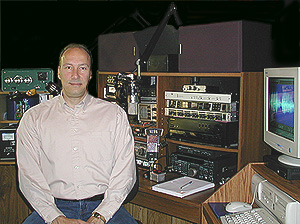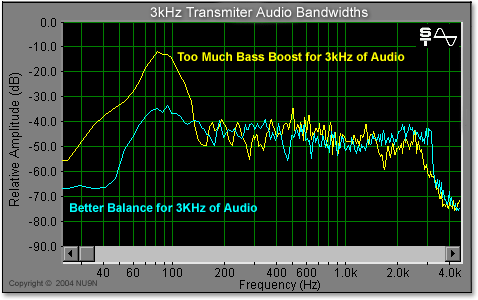
 |
NU9N SSB Audio News Editorial - October, 2004
|
HOW MUCH BASS IS TOO MUCH?
 (Balance is Everything
!!!) (Balance is Everything
!!!)
Newcomers experimenting with audio is an encouragement to me!
However, I and others have noticed an over-processing of the bass frequencies with many new (and old) audio enthusiasts, in particular with SSB operators with 3kHz of audio bandwidth or less.
To some extent, this is a subjective matter. Certainly, there is room for creativity where audio balancing is the task. However, there is a science in balancing audio also and some tried and true methods for determining what to do are
available. If a thick heavy low end is desired, there MUST be enough high frequency emphasis to balance it. Otherwise, it's just "Mush".
When a transmitter's filter (DSP or Analog) cuts the audio bandwidth above 3kHz, the freedom one has to boost bass frequencies diminishes if a relative "Balance" of audio is the goal. Sure, bass sounds good and has an attractive
and powerful sound to it. But if boosted too much, it can destroy any sense of audio balance thus leaving the audio too mushy, dull and in some extreme cases difficult to copy at all... especially when signals are weak. It is a noble
thing to want to sound good... I think everyone likes to hear those unsolicited words... "You sound great!". But what is it that prompts that type of comment?
A 3kHz SSB signal is definitely a challenge to make sound good. With only 3kHz of audio to work with, the balancing act is critical if a pleasant smooth low-end is desired with the proper amount of high frequency articulation to balance
the audio signal.
First, lets look at a well balanced 3kHz audio spectral analysis vs. a poorly balanced 3kHz audio spectral analysis:

The Cyan colored audio spectral analysis sounded well balanced even though the operator was exciting frequencies below 100Hz. This is due in part due to the even amplitude that was used across the passband as well as a high frequency
cut-off that was at about 3.2kHz.
Notice the huge 30dB "hump" in the Yellow audio spectrum from 60Hz ~ 120Hz. This extreme boosting would be too much even if there were proper high frequency audio energy present to balance the signal, but 3kHz is not enough
for this kind of bass boosting in any case. What makes matters worse is the fact that Yellow station's high frequency roll-off is at 2.7kHz not 3kHz.
The Formula for Balance:
Bell Laboratories did an in-depth study many years ago to determine the balancing of audio frequencies necessary to achieve good communications quality. Even though the study is old, was focused on telephone communications at 3kHz and
is now somewhat outdated, the principle is still a valid one. The formula looks like this:
| BELL LABS EVEN FREQUENCY DISTRIBUTION
(Assuming a Constant -3dB/Octave Amplitude Decline)
Formula 1
6000.000 / available high freq = required low frequency @ -3dB
Formula 2 (Inversed)
6000.000 / desired low freq = required high frequency @ -3dB
Examples:
1)
Using formula 1 where a known high frequency cutoff is 3kHz then:
600,000 / 3000 = 200 Hz @ -3dB
This means that for an audio bandwidth of about 3kHz, we should be rolling off below 200 Hz with 200Hz already dropping by -3dB.
2)
Using formula 2 with a desired low frequency of 100Hz, then:
600,000 / 100 = 6000 Hz @ -3dB
This means that for a desired low end response of 100Hz, then the top frequency must be 6000Hz at the -3dB point. |
| NU9N MODIFIED EVEN FREQUENCY DISTRIBUTION
(Assuming a Constant -1.5dB/Octave Amplitude Decline)
Formula 1
3000.000 / available high freq = required low frequency @ -3dB
Formula 2 (Inversed)
3000.000 / desired low freq = required high frequency @ -3dB
Examples:
1)
Using formula 1 where a known high frequency cutoff is 3kHz then:
300,000 / 3000 = 100 Hz @ -3dB
This means that for an audio bandwidth of about 3kHz, we should be rolling off below 100 Hz with 100Hz already dropping by -3dB.
2)
Using formula 2 with a desired low frequency of 80Hz, then:
300,000 / 80 = 3750 Hz @ -3dB.
This means that for a desired low end response of 80Hz, then the top frequency must be 3700Hz at the -3dB point. |
The bottom formula is my modified version of the first formula and should produce a good balance with more bass boosting than the Bell formula allows. In the bottom formula, notice that with a transmitter limited to 3kHz of audio response
on the top-end, the lowest frequency that should be administered is 100Hz at the -3dB point. In my formula, I am even being generous to allow 100Hz in a 3kHz bandwidth since again, the original formula calls for a cutoff at 200Hz at the
-3dB point if 3kHz is the high frequency roll-off.
Our ears and brains are good at deciphering information, but with a 3kHz passband with bass frequencies boosted by 20dB or more @ 80~120Hz, the intelligibility factor diminishes in a hurry!
My suggestion? ... Use ONLY the amount of bass boost that the transmitter needs to balance the high frequency roll-off properties inherent with the filters being used. If you want more bass than the formula allows for 3kHz of audio,
then consider making arrangements to extend the high frequency capabilities of the transmitter. At 4kHz, you have more liberty with bass, and with 5kHz even more yet... etc...
A final note - Listening Narrow:
If you are listening in 3kHz, and hear someone who sounds "Too Bassy" to you, do not be quick to judge them! They may be perfectly balanced for the transmitter audio response they are using... But your receiver may not be able
to hear that because of the reverse problem I have been discussing here. It works both ways! If you want to hear the proper balance of another station's transmitter that is beyond 3kHz of bandwidth, you must make sure that your receiver
has the appropriate bandwidth to properly demodulate them as well. If your receiver cannot hear more than 3kHz of audio, I would suggest to say nothing at all since you have no way of knowing what they are doing.
73,
-John Anning, NU9N
|
|




